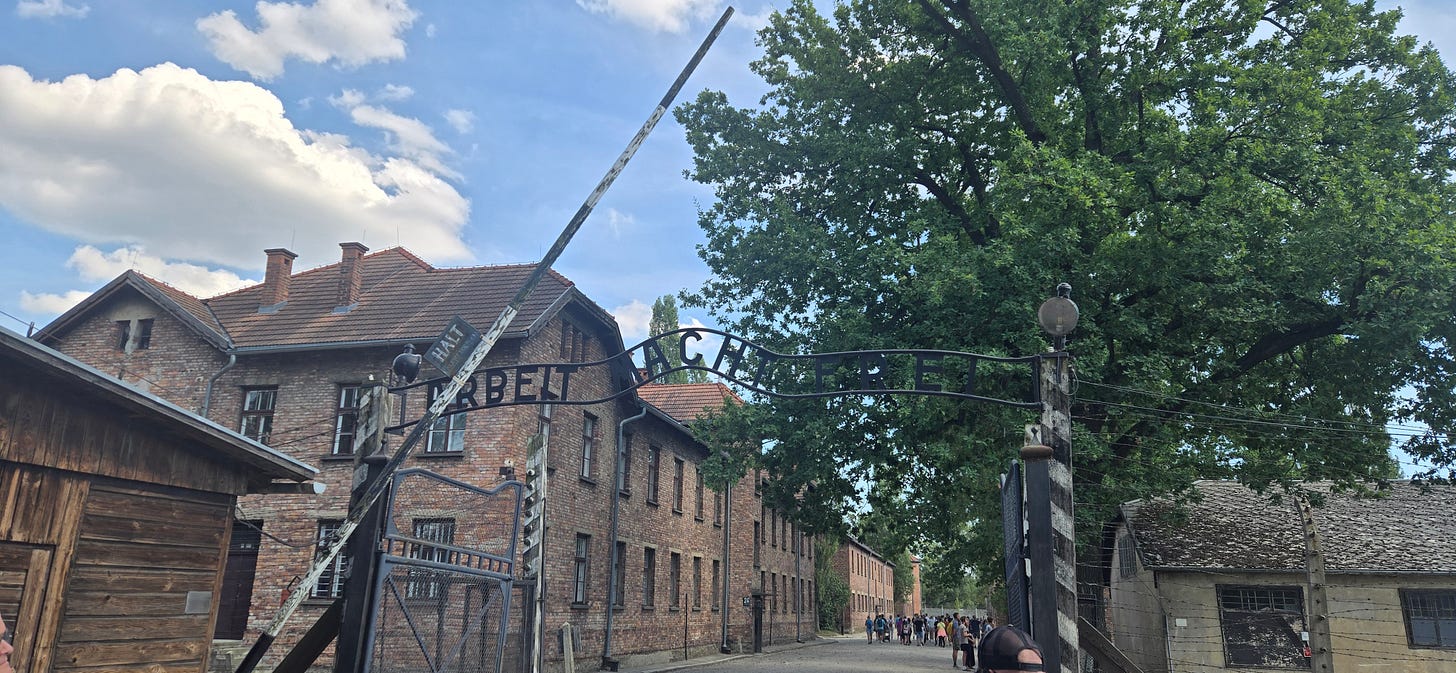Reflections from Auschwitz
Evidence preservation in the technological age
Last week I went to Auschwitz. It was a heavy experience, to say the least. Auschwitz is a place I’ve learned and read about for as long as I can remember. The Diary of Anne Frank was assigned reading at a very young age, and I studied the Nuremberg Trials in graduate school. Yet, despite knowing what happened there, no amount of pre-reading could have prepared me for the haunting feeling of being in the barracks where the Nazis kept the Jews, Polish political prisoners, Roma, and anyone else they deemed undesirable, and feeling, with my own hands, the wooden planks on which they slept in cramped, disease-filled rooms.
It was startling to learn how the Nazis almost successfully covered up the killing of 1.9 million people. Most of the images we have of Auschwitz came from pictures taken by German soldiers in their ever-banal and meticulous documentation process. The SS tried to destroy much of the evidence of genocide once they realized the Soviets were advancing toward their position. These images, by chance, were not destroyed, and, also by chance, were found by a young girl who survived the camp.
Surviving eyewitnesses were nearly nonexistent. The Sonderkommando, Jewish prisoners forced to dispose of the victims’ bodies and therefore some of the few non-Nazi eyewitnesses to the crimes, barely survived the camp—only 20 of the thousands of Sonderkommando who were in Auschwitz survived and then testified about the crimes.
The evidence collected at Auschwitz and other camps was crucial to convicting the war criminals at Nuremberg and other subsequent trials. But if a crime that large could be nearly covered up 80 years ago, could that happen today? Sensors are everywhere and documenting everything, but just because wars are being live-streamed doesn’t mean the world knows what is going on 100% of the time. Moreover, there is a difference between documenting a crime, using that documentation in court, and then believing the documentation is real.
I’ve compiled some articles that discuss what technology and systems make documenting war crimes easier, where the challenges are, and what technology is making proving crimes more difficult (hint, it’s deepfakes).
What is easier
In some ways, documenting and proving crimes has never been easier. Sensors are everywhere. Anyone using Google Maps can access pretty good and up-to-date satellite imagery. NASA operates a site that has even better imagery available for free. For a couple of hundred dollars, you can get even better imagery from a commercial provider, such as SkyFi. Larger enterprises with more capital can have capabilities previously reserved for only the most sophisticated state actors.
One of the best-known names in Open Source Intelligence (OSINT) is Bellingcat.
They conduct investigations, provide guides, resources, and case studies, and actively help archive online evidence. Their OSINT toolkit offers tools for investigating corporations, identifying phone number leaks, following key individuals on X for OSINT news, and more. For the amateur sleuth with no experience, the world really is at their fingertips.
Despite all the OSINT tools out there, it really does not get easier when war criminals live-stream their war crimes.
It doesn’t take much digging on X to find accounts that post combat footage. Some of this footage is valuable OSINT information from trusted sources. Other times, it is simply war porn. The Wagner Group is notorious for doing this, and they are monetizing their war crimes without consequence. While live-streaming war crimes certainly falls into the “making it easier to prove” category, as I’ll discuss later, you still have to bring the criminals to trial. I encourage everyone to read the linked story about the Wagner Group. It shows the disparity between ICC investigations around the world and rightly draws parallels (or a line of continuity) from the Heart of Darkness and King Leopold’s Congo.
We all carry surveillance devices around 24/7.
Everyone carries a small, portable device equipped with a microphone, cameras, and GPS systems constantly pings your information to and from cell towers and wifi stations while updating scores of applications (some of which you cannot see) with various pieces of information, including your location, what you are buying, how you are buying it, what you are watching, and who and when you are talking to someone. This privacy nightmare is a criminal detective's wildest dream. Here are two stories where a criminal’s cellphone was enough to land a conviction.
The challenges
With a flood of new technology, there comes a flood of new challenges. When there are massive amounts of digital data, that data needs to be stored securely, authenticated, and be admissible into a court of law. Here are some stories detailing precisely those challenges.
The Problems of Digital Evidence: How authenticating, securing, and protecting digital evidence is problematic at the world's International Criminal Court
While new technologies and new investigative methods hold great promise for improving avenues for international justice in many ways, authenticating digital evidence is a major challenge. Authentication ensures digital information is what it purports to be—in other words, it has not been altered, manipulated or forged. Authentication is important, as digital evidence is more susceptible to compromise, forgery, manipulation, and deletion than traditional physical, documentary, or testimonial evidence. Unlike other forms of evidence, there is no analog reference for most forms of digital evidence. In addition, social media’s amplification of disinformation in international conflicts has increased the ‘fog of war’, running the risk of entrenching potentially misleading or false information in eyewitnesses, investigators, and judges.
What the Afghanistan Withdrawal Teaches Us About Safeguarding Human Rights Evidence
In [2021] mid-August, the Taliban swiftly advanced to take control over the Afghan territory and government. […] While vulnerable individuals were understandably and rightfully prioritized in the evacuation efforts, non-human materials and resources were left behind in the chaos of the Taliban’s takeover. Included in the materials left behind were hardcopy archives that international civil organizations and the Afghan Independent Human Rights Commission had collected to document human rights abuses committed by the Taliban, Afghan forces, and other actors. Over decades, human rights investigators had amassed thousands of pages of evidence including victim affidavits, photographs and videos of human rights abuses, and forensic evidence related to mass graves. Sensitive personal identifying information of victims, witnesses, and human rights documenters was also embedded in these documents. […]
But it did not have to be this way. Modern storage and verification technologies could have been leveraged to neutralize these risks. This article delves into the technical details of attempts to modernize today’s evidence safehouses (including those of the Starling Lab, with which this author is affiliated) and how these technologies’ might be deployed in future investigations that take place in high-risk conflict zones.
While a citizen, journalist, and lawyer may all deem something an “atrocity” if it is actually a “war crime” (and one that has a chance of being successfully prosecuted), it takes a trained eye to distinguish it. These trained eyes are few in comparison to the massive amounts of data that need to be sorted. AI is partly solving this problem, but the gap between identifying something as a war crime and prosecuting it remains significant. This story describes just that journey of an ad hoc group of Ukrainian citizens who went to work during the opening hours of the full-scale invasion:
The Hour These Hostilities Began’: Ukrainians Mobilize to Document War Crimes
Investigators must track down and verify the sources of such information, not an easy task when drawing from the Internet, where the habit of posting under a pseudonym and the proliferation of “deep fakes” can complicate the authentication of data. Villagers coming to retrieve, honor, and bury their dead, and the journalists rushing to capture and report the ravages of Russian aggression, are engaged in understandable, important, and humane endeavors. But their early presence at a crime scene can compromise the ability to establish identifying information about the attackers that is critical in building cases. And all this technological progress can be hindered by the slow pace of traditional judicial procedures.
AI-Generated Voice Evidence Poses Dangers in Court
Evidence rules are also outdated. This piece discusses the antiquated rules around allowing a voice recording into evidence. All that is needed is someone to be “familiar with the voice” to allow the recording. You can imagine, with AI voice fakes being so good, plenty of fake recordings may be admissible as legitimate evidence unless the rules are changed.
The difficulties
Deepfakes. Deepfakes are a massive problem. For starters, they create problems where they don’t exist. This Guest Essay by Senator Amy Klobuchar, a recent victim of a deepfake, articulates the problem.
Amy Klobuchar: What I Didn’t Say About Sydney Sweeney
As anyone would, I wanted the video taken down or at least labeled “digitally altered content.” It was using my likeness to stoke controversy where it did not exist. It had me saying vile things. And while I would like to think that most people would be able to recognize it as fake, some clearly thought it was real. Studies have shown that people who see this type of content develop lasting negative views of the person in the video, even when they know it is fake.
Creating controversies that do not exist applies to war crimes investigations as readily as it does to politics. As mentioned above, investigative resources for international crimes are scarce, and having investigators chase crimes that didn’t happen is an unnecessary distraction—and possibly a future tactic for states and individuals trying to avoid punishment. Even worse, the stigma that comes with even being accused of a crime is high, and false accusations can have long-lasting negative repercussions.
Deepfakes present a new type of deniability.
If everything could be fake, then something real could easily be waved off as such. Here is an older post I wrote about just this.
Weekly Roundup: Deepfakes Meet Swift Resistance: Politicians and T-Swift confront deepfakes and the war on truth
In sectors like [politics] and journalism, this “new kind of deniability” means that organizations or individuals must go to greater lengths to prove facts than they ever have before. If every scandal, unsavory piece of reporting, or inconvenient truth could plausibly be a deepfake, then the threshold for truth will be extraordinarily high. This could manifest in a way where everything reported is false until proven beyond a reasonable doubt to be unimpeachably true. Or, it could manifest in an extreme version of “he-said, she-said,” where the truth-teller is simply the person with the more amenable personality.
Lastly, despite all the new tools, digital evidence, and the seemingly thousands of eyeballs watching everything all the time, there are still massive amounts of unknowns.
Here is another excerpt of the “Hour the Hostilities Began” story linked above.
All of these matters pertain to the slaughter of civilians. We also confront a whole different category of offense: the forced relocation of thousands of Ukrainian citizens, including children, to Russia. Their location is unknown, communication is impossible, and investigators have no access to Russian terrain. Proving the crime of kidnapping will be hard. And establishing factual links between so many individual atrocities and the criminal intent of Russia’s political and military leadership will be harder still.
What Happens When There is no Nuremberg?
One of the reasons the Holocaust has proved such an enduring testament to the perils of authoritarianism, racism, the banality of evil, and aggressive war is that victorious nations put the crimes on trial, publicly. Evidence was collected, presented, and tried. The accused had a chance to mount a defense, and then, many of them, because of overwhelming evidence, were sentenced.
Except for fringe groups, very few doubt the existence of the Holocaust. Perhaps, a close counterexample to what happens when there is no public trial or documentation of evidence is the Genocide of Poles in Volhynia, and subsequent forced resettlement of Ukrainians a few years later. Volhynia is still talked about among the Polish population with great resentment and anger. Many in the rural Polish borderlands hate the Ukrainians as a collective for Volhynia. Perhaps if the perpetrators were publicly held responsible, there would have been no need to force 150,000 people from their homes in revenge, and there would be some closure for the descendants of the victims.
Ukraine is not the only nation falling victim to atrocious war crimes. China is actively committing a genocide against the Muslim Uyghurs. The famine in Gaza is a war crime. Sudan may be in the midst of a genocide, and is undoubtedly in the midst of an oft-overlooked famine. For an undeniable record of these atrocities to survive, there must be accountability for the criminals. Accountability can only be achieved through public trials and the presentation of meticulously documented evidence. Public trials can only occur if a nation has achieved victory over the criminals. The world narrowly avoided a cover-up and Auschwitz, and despite the challenges with modern digital evidence collection, there is no excuse for war crimes to go unprosecuted in the 21st century.
Resources
Below are some resources you might find useful for OSINT, Privacy, and the ICC.
Berkeley Protocol on Digital Open Source Investigations: A Practical Guide on the Effective Use of Digital Open Source Information in Investigating Violations of International Criminal, Human Rights, and Humanitarian Law
Other Pioneering Oversight stories on War and International Law
(Parts II and III of “Regulating Autonomous Weapons” are linked in Part I)
If you’ve enjoyed this article, please consider supporting this publication in a few easy ways.
Like and share this article or Pioneering Oversight with a friend.
If you aren’t subscribed, consider liking and sharing the publication anyway, and of course, subscribing.
If you like what I’m writing, I always appreciate restacks, quotes, and comments!





